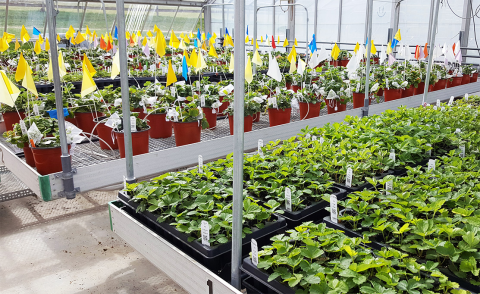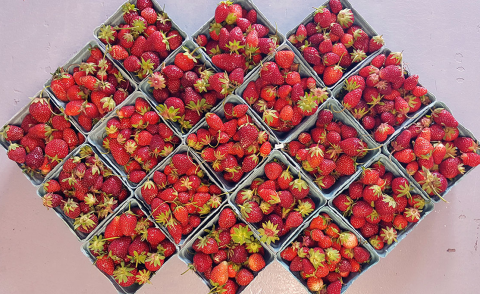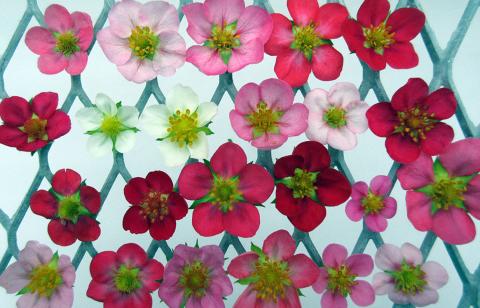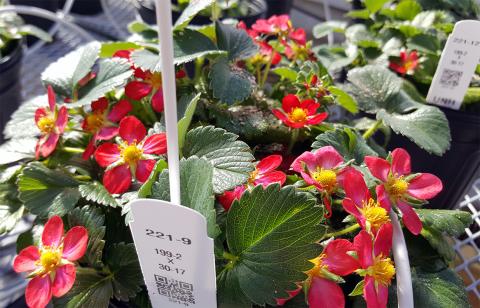Key Findings

Research has significantly advanced genomic and technical information on cultivated strawberries.
Genomic information is being used to develop northern New England-specific organic strawberry varieties.
Crossing wild strawberry relatives with cultivated strawberries has been used to develop ornamental varieties with richly colored fruit and flowers ranging in color and hue from coral and lavender to orangish and raspberry red.
About the Co-Author
Lise Mahoney, Research Assistant Professor, Agriculture, Nutrition, and Food Systems
Contact information: Lise.Mahoney@unh.edu
This research was published in the INSPIRED: A Publication of the New Hampshire Agricultural Experiment Station (Summer 2022)
Researchers: L. Mahoney
With over 700,000 pounds produced and $2.3 million in farm sales, strawberries are an important crop for New Hampshire farmers. But improving the cultivated strawberry through breeding is particularly challenging. The cultivated strawberries has four times as many chromosome sets as humans, animals and most other crops, which significantly increases its genomic complexity. Research to untangle the plant's genetic structure will enable scientists to more quickly and effectively develop cultivated strawberry varieties that help New England farmers be more resilient and successful.
Strawberry genetics research at UNH
The cultivated strawberry is a challenging species for genetic studies due to its genomic complexity. Humans, most agricultural animals and many crop plants—including Gregor Mendel's peas—are "diploids," possessing two sets of chromosomes with one set inherited from each parent. The cultivated strawberry, however, is an "octoploid," having eight sets of chromosomes with four sets inherited from each parent.
New Hampshire is host to two wild strawberry species: the woodland strawberry (Fragaria vesca), a diploid, and the Virginia strawberry (Fragaria virginiana), an octoploid. Fragaria vesca was designated by the international strawberry community as a suitable species for genetic research. The UNH strawberry genetics and breeding initiative began in the mid-1990s with investigations into the evolutionary ancestry of the cultivated strawberry (Fragaria × ananassa) and efforts to develop genomic information and technical resources that could ultimately support a program of marker-assisted (DNA-based) breeding. In 1997, researchers created the first genetic map of F. vesca and established the chromosome numbering for all subsequent strawberry genetic and genomic maps.
Additionally, UNH researchers took a leading role in the design of the first high-throughput technology for marker-assisted strawberry breeding—the IStraw90® Strawberry SNP array—as members of the U.S. Department of Agriculture Specialty Crop Research Initiative "RosBREED". The IStraw90® technology enables strawberry breeders to test as many as 90,000 chromosomal sites in each plant of a breeding population. Now, the focus is to use this technology to breed seed-propagated strawberry varieties for organic production in northern New England.
Organic edible strawberry breeding
With the aid of the IStraw90® genotyping technology, researchers are developing strawberry varieties for organic agriculture. The varieties will include both vegetatively propagated and seed propagated selections. Seed propagation is particularly important because the strawberry's genetic complexity precludes the crop from breeding true from seed. Rather, strawberry varieties have traditionally been clonally propagated from runners and sold as bare-root plants, which are difficult to organically certify.
The development of organically certified, seed-propagated strawberry varieties is being done by selecting hybrids of regionally favored varieties, reducing their genetic complexity through inbreeding and then selecting out undesired genomic areas. This method reduces the genetic heterozygosity of the plants by half with every generation.
F1 (i.e., the first filial generation of offspring produced by crossbreeding) hybrids were generated between fourth generation inbred plants. These F1 progenies were planted in organic plots at the Woodman Horticultural Research Farm in the summer of 2021. Crosses and inbreeding were conducted in the climate-controlled, organically certified chambers in the Macfarlane Research Greenhouses. Pollination sources were controlled by using mesh bags enclosing the fertilized female developing fruit. Evaluating these F1 families will occur in summer 2022. The families are being evaluated for fruit flavor, size and yield, as well as plant vigor and health. Inbreeding has progressed to the sixth generation in some lineages to further reduce residual heterozygosity.
This research was partially supported by a USDA National Institute of Food and Agriculture Organic Research and Extension Initiative grant.


Left: Strawberries being grown in the organically certified chamber of the UNH Macfarlane Research Greenhouses. Right: UNH research is underway to breed organic strawberries for the New England region.
Ornamental strawberry breeding
A group of pigments that includes two types of anthocyanins—pelargonidin and cyanidin—are responsible for strawberry flower and fruit color or hue variations. Pelargonidin confers the typical orange-red color of a strawberry and cyanidin confers the raspberry red color. Marker-trait associations for the presence and absence of flower color have been identified and may also be linked with a number of anthocyanin pathway genes, including "MYB regulators". This was the inspiration for crossing wild and cultivated strawberries to develop varieties for the northern New England region with richly pigmented fruit and varieties with beautiful flowers ranging in color and hue from coral and lavender to orange and raspberry red. Evaluation of advanced selections of ornamental bedding plants began in 2021 and evaluation of new seedlings will be completed in summer 2022. Additional selections are being propagated for a focused trial during summer 2022.


New NHAES-funded research allows for the breeding of many different-hued strawberry flowers.

